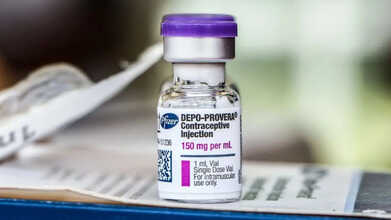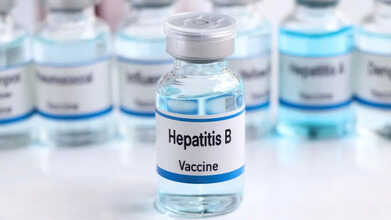- Health Conditions A-Z
- Health & Wellness
- Nutrition
- Fitness
- Health News
- Ayurveda
- Videos
- Medicine A-Z
- Parenting
US Researchers Develop At Home Saliva Test That Detects Hidden Depression Risks

Credit: Canva
Researchers at the University of Cincinnati, US have developed a portable "lab-on-a-chip" device that offers a rapid, objective method to assess stress and mental health risks by measuring cortisol levels from saliva. This innovative device consists of a disposable saliva collector and a handheld reader that transmits the results to a smartphone in minutes.
Unlike conventional mental health questionnaires that rely on self-reporting, this device provides biochemical data, allowing clinicians to make timely and accurate mental health interventions. It also has potential applications beyond stress detection, such as identifying cardiac biomarkers like troponin, which could aid in diagnosing heart attacks.
The device, developed by UC College of Engineering and Applied Science Distinguished Research Professor Chong Ahn and his team, was recently featured in the journal Biomedical Microdevices. The study highlights how elevated cortisol levels can indicate chronic stress and mental health disorders like anxiety and depression, even in patients who do not report feeling stressed in standard assessments.
Doctoral student Supreeth Setty is further exploring how another hormone, dehydroepiandrosterone (DHEA), interacts with cortisol. Research indicates that a high cortisol-to-DHEA ratio is a potential marker for chronic stress, making it a critical factor for clinicians in diagnosing mental health conditions.
The device’s user-friendly design enables patients to conduct the test themselves and share results with doctors via a smartphone app. This point-of-care testing approach not only facilitates quicker interventions but also reduces the subjectivity associated with mental health assessments.
Beyond mental health, UC researchers are investigating the device’s potential to detect heart conditions. In another study published in Analytical Chemistry, the team developed a blood test to measure cardiac troponin levels. Elevated troponin levels indicate heart damage and could signal a heart attack in progress. The researchers aim to use this rapid test to monitor troponin levels in heart attack survivors, potentially preventing subsequent cardiac events.
UC doctoral graduate Vinitha Thiyagarajan Upaassana, a lead author of the study, emphasizes the significance of immediate test results in critical care settings. “The test provides immediate results, which is vital when a patient is in need of urgent care,” she said.
The research was partially funded by UC’s Technology Accelerator Project, and the team plans to collaborate with psychiatrists to conduct clinical trials to validate the platform’s effectiveness in real-world scenarios.
If successful, the lab-on-a-chip technology could revolutionize mental health and cardiac care by providing rapid, point-of-care biochemical tests that deliver immediate, actionable data to clinicians.
Depo Provera: New FDA Label Highlights Possible Brain Tumor Risk

Credits: AP
Depo Provera: The Food and Drug Administration approved a label change on Friday for Pfizer’s birth control injection, Depo-Provera, alerting patients to the risk of meningioma, a tumor that develops in the lining of the brain.
Pfizer is currently facing a lawsuit from over 1,000 women who allege that the company knew about the risk but failed to warn users.
How Depo-Provera Works
Depo-Provera is administered as a progestin injection every three months. The lawsuit highlights studies dating back to 1983 linking progesterone with meningioma, claiming that Pfizer had an “unassignable duty to investigate” and should have examined the potential risks of Depo-Provera much earlier. (Progestin is a synthetic form of progesterone.)
According to the Centers for Disease Control and Prevention, roughly one in four sexually active women in the U.S. has used Depo-Provera, with Black women using it at nearly twice the national rate.
Depo Provera: Understanding Meningiomas
Meningiomas are generally non-cancerous, meaning they do not spread to other areas of the body. However, depending on their size and location, they can still be dangerous. In the U.S., about 39,000 meningiomas are diagnosed annually, though the overall risk remains small, as per CDC.
Depo Provera: Pfizer’s Response and FDA Review
Earlier this year, Pfizer requested a judge dismiss the lawsuit, stating that it became aware of the meningioma risks linked to Depo-Provera in 2023. In February 2024, the company applied to the FDA to add a warning to the injection’s label, also requesting warnings for two lower-dose pills containing medroxyprogesterone acetate (MPA), the active ingredient in the shot, as per NBC News.
The FDA denied the request for the pills, explaining that “the findings of the available observational studies alone do not support the addition of a warning on Meningioma risk to medroxyprogesterone acetate (MPA)-containing products.”
Pfizer then amended and resubmitted the application in June 2025. In response, the FDA approved a label change this month for two injection versions — Depo-Provera CI and Depo-Subq Provera 104.
“We acknowledge receipt of your amendment dated June 12, 2025,” the FDA letter to Pfizer said. The approval “provides for the addition of information related to Meningioma risk” on the product label.
Depo Provera: Pfizer’s Statement
A Pfizer spokesperson told NBC News that “the label update reflects a recent decision by the FDA to approve the warning, which the agency had earlier denied.”
“Pfizer stands behind the safety and efficacy of Depo-Provera, which has been used by millions of women worldwide and remains an important treatment option for women seeking to manage their reproductive health,” the statement added.
Lawyers representing the women suing Pfizer said: “For years, Pfizer misled doctors, patients, and the FDA about Depo-Provera’s link to meningiomas, resulting in needless suffering for thousands of women who developed these serious brain tumors. … We applaud the FDA in finally requiring this label change to better inform and protect women.” The FDA did not immediately respond to requests for comment. Elsewhere, warnings about meningioma have already been added to Depo-Provera’s label.
In 2024, the European Medicines Agency listed meningioma as a “possible side effect” for drugs with high doses of MPA. That same year, Canada updated the drug’s label to include meningioma under “warnings and precautions,” noting that meningiomas have been reported following long-term use of progestins, including MPA.
As per NBC News, in January, South Africa’s regulatory agency recommended updating the MPA drug label to include meningioma risk as well. The judge has not yet issued a ruling in the ongoing lawsuit against Pfizer in the United States.
CDC Formally Ends Universal Hepatitis B Vaccination Guidance—What Does It Mean For Newborns?

Credits: Canva
The U.S. Centers for Disease Control and Prevention on Tuesday withdrew its decades-old guidance that all newborns in the country should be vaccinated against hepatitis B at birth. Instead, the decision has now been shifted to parents, who are advised to consult a healthcare provider when deciding whether babies born to hepatitis B-negative mothers should receive the vaccine, including the birth dose.
The change follows a recommendation made by Health Secretary Robert F. Kennedy Jr.’s vaccine advisory panel, marking a significant shift in public health policy. Earlier this month, the panel suggested that the birth dose be limited to newborns whose mothers test positive for hepatitis B or whose infection status is unknown. The CDC approved this recommendation as official policy on Tuesday. Here is what this change means for newborns moving forward:
Also Read: Indoor Air In Delhi Is More Toxic Than Outdoor Smog, Pulmonologist Warns
CDC Ends Guidance That All Newborns Should Get Hepatitis B Vaccine
Under the updated guidance, if parents decide against vaccinating their baby at birth but later believe the shot is necessary, the CDC now advises waiting until the child is at least two months old before administering the first dose. Since 1991, U.S. health authorities have supported universal infant vaccination against hepatitis B, with the first of three doses typically given shortly after birth. CDC recommendations influence health insurance coverage decisions and serve as a key reference point for doctors when determining vaccine schedules.
Public health experts have raised concerns that the shift toward what the CDC calls “individual-based decision-making” may leave more children vulnerable to the virus and could encourage families to skip vaccination without a strong federal directive. Kennedy, who has long opposed vaccines, has already introduced sweeping changes to the country’s vaccination policies.
CDC New Guidance On Hepatitis B Vaccine: What Does This Mean For Newborns?
Rather than advising hepatitis B vaccination for every newborn, the CDC now formally recommends that women who test negative for the virus discuss with their healthcare providers whether their babies should receive the first dose within 24 hours of birth. According to NBC News, the agency is also evaluating another proposal from the advisory panel, which suggests parents consult doctors about testing children for hepatitis B antibodies before deciding on second doses of the vaccine. Typically, the hepatitis B vaccine is administered as a three-dose series during infancy.
Also Read: ‘Fix Your Handwriting’: Indian Doctors Told to Write Clear, Legible Prescriptions Under New Rules
This policy shift stands out as one of the clearest departures from established medical consensus reflected in current CDC guidance. During discussions, the advisory committee relied on selective data and misinformation, while overlooking decades of research showing that hepatitis B vaccines are both safe and highly effective when given soon after birth.
“Removing the recommendation for newborns increases the likelihood that case numbers will rise again. This makes America sicker,” Senator Bill Cassidy, R-La., a liver specialist who has treated hepatitis B patients, wrote on X earlier this month. Despite the change, pediatricians are still expected to encourage parents to vaccinate their newborns.
The Department of Health and Human Services has stated that the updated guidance will not change insurance coverage for the vaccine. The shots will also remain available to newborns through the Vaccines for Children Program, which provides vaccines at no cost to uninsured or underinsured families.
Last month, the CDC also revised a webpage that had previously stated clearly that vaccines do not cause autism. The updated language now says studies have not ruled out a link, despite decades of scientific evidence showing no connection between vaccines and autism.
‘Fix Your Handwriting’: Indian Doctors Told to Write Clear, Legible Prescriptions Under New Rules

Credits: iStock
No more scribbling, notes a BBC report from October 1, 2025, where the Punjab and Haryana court tells doctors to fix their handwriting. Now, the National Medical Commission or NMC has issued nationwide order to the doctors to ensure their prescriptions are written in a clear and legible manner.
While jokes around the notoriously bad handwriting of many doctors that only can be read by pharmacist are common in India, but after the High Court's ruling, this joke is taken seriously. The High Court noted that "legible medical prescription is a fundamental right" as it can make a difference between life and death.
What Are The New NMC Guidelines On Doctor's Handwriting?
Under the new directive, the NMC ordered that doctors must:
- Write prescriptions in clear, legible handwriting, avoiding ambiguity.
- Arbitrary or unclear prescription writing will no longer be acceptable, as it compromises patient safety.
- Subcommittees will be formed in all medical colleges to monitor prescription practices and ensure compliance.
- Medical students will be taught the importance of clear prescription writing, making it a core part of clinical training.
The Background Of NMC Guidelines

The Punjab and Haryana High Court ordered doctors to fix their handwritings while it was looking at a case that involved allegations of rape. While checking a medico-legal report written by a government doctor who examined the woman, the court found it incomprehensible.
Justice Jasgurpreet Singh Puri said, "It shook the conscience of this court as not even a word or a letter was legible".
"At a time when technology and computers are easily accessible, it is shocking that government doctors are still writing prescriptions by hand which cannot be read by anybody except perhaps some chemists," said Justice Puri.
Importance Of Clear Prescriptions
The World Health Organization (WHO) identifies medication errors as a major global patient safety challenge, contributing to avoidable injuries and deaths worldwide. Illegible prescriptions are a well-recognised cause of such errors.
A clear and readable prescription also:
Prevents misinterpretation
Poor handwriting leads to misinterpretation of the intended drug name, dosage, or instructions. Many drugs have names that look or sound alike, making clarity critical.
Ensures the right dosage
Unclear instructions when it comes to dosing result in giving out doses that are ten or one hundred times the correct amount, leading to toxicity or therapeutic failure.
Empowers patient understanding
When the patients are able to clearly read and understand the prescriptions and medication labels, they are more likely to take their medications correctly, reducing the margin for errors.
Reduces healthcare costs
Medication errors resulting from unclear prescriptions lead to increased hospital admissions, prolonged lengths of stay, and additional costs, placing a significant burden on the patient and the healthcare system.
© 2024 Bennett, Coleman & Company Limited

